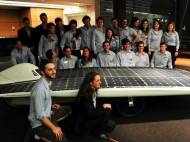Sunswift IVy sets the world record for the fastest solar car
 University of New South Wales (UNSW) Sunswift solar car has been developed for almost 15 years, and its current version – Sunswift IVy – managed to set a new Guinness World Record as the world’s fastest vehicle powered by the sun. The car smashed the world solar car speed record at the HMAS Albatross navy base airstrip in Nowra, traveling at an average speed of 88km/h (almost 55 mph).
University of New South Wales (UNSW) Sunswift solar car has been developed for almost 15 years, and its current version – Sunswift IVy – managed to set a new Guinness World Record as the world’s fastest vehicle powered by the sun. The car smashed the world solar car speed record at the HMAS Albatross navy base airstrip in Nowra, traveling at an average speed of 88km/h (almost 55 mph).
“We broke the record at 10.32 this morning”, said Daniel Friedman, Sunswift project manager. “The Guinness World Book of Records adjudicators were on hand, so it’s all official. We’ve even been handed our certificate.”
The speed was significantly faster than the previous record of 79km/h (49 mph). The record was set for cars that are powered exclusively by silicon solar cells. Although Sunswift IVy normally uses its cells to charge a 25kg (bit more than 55 pounds) battery to operate, the battery was removed for the record attempt. Friedman said the team was excited that the car performed so well, because they expected to set the record when the sun was at its peak at noon.
“We hope the news will spur a lot more interest in solar energy and the debate about renewable energy technology”, Friedman added.
Sunswift IVy is designed and built by UNSW students. It has a similar size as an average sedan, but with half the height and 1/10th of the weight of an average car. While students are also usually the drivers of the carbon-fiber race vehicle, professional racing driver Barton Mawer and Craig Davis, from electric car firm Tesla’s European operations, were drivers for this attempt.
“We were confident… we only needed a little bit of sunshine and that was enough”, Mawer said. “I’ve been lucky enough to drive racing cars all around the world but this was right up there as a buzz. To grab the world record is just great for the whole team, and the University of New South Wales put in a big effort to get this done and hopefully we can keep chipping away at it to raise the bar.”
IVy produces about 1200 watts – the same power it takes to run a toaster. The car managed to reach higher speeds, with a top speed of 103km/h (64 mph) during the 3000km (1865 miles) Global Green Challenge race from Darwin to Adelaide in 2009, in which the team won the first place in their category.
Sure it looks a bit large and uncomfortable, and Maver said the car handled reasonably well, “although I think I gave the team a bit of a scare when I got up on two wheels on the turn”. However, it is a start that demonstrates how we could incorporate solar technology in order to provide (additional) power for the vehicles of the future. Did I mention the Sunswift project is open source?









GD, your second to last line raises a key point. Just as you would never buy an F1 car as a grocery getter, solar cars are meant as test beds for developing technology which can directly benefit consumer vehicles. Solar cells may never power your car’s motor, but they may become commonplace for powering your car’s ancillary systems.
Congratulations to those involved in the car fabrication.
Dr.A.Jagadeesh Nellore(AP),India
I agree with the author and Kristen.
This system could be incorporated design-wise, where you could combine LED lights powered by modern looking racing stripes made of solar panels.
It could also power an automated system where the vehicle would be ventilated or cooled while it is parked on direct sunlight.
author
That was my point – at least for near future scenarios.
Unless we witness major breakthroughs in existing technologies, or some new technology emerges, I do believe the next generation of vehicles will rely on hydrogen fuel and auxiliary electrical power.
Well done team good to see some kiwis in the mix
author
The team recently announced that they got Sunswift IVy up to 110km/h (68mph)on the track.